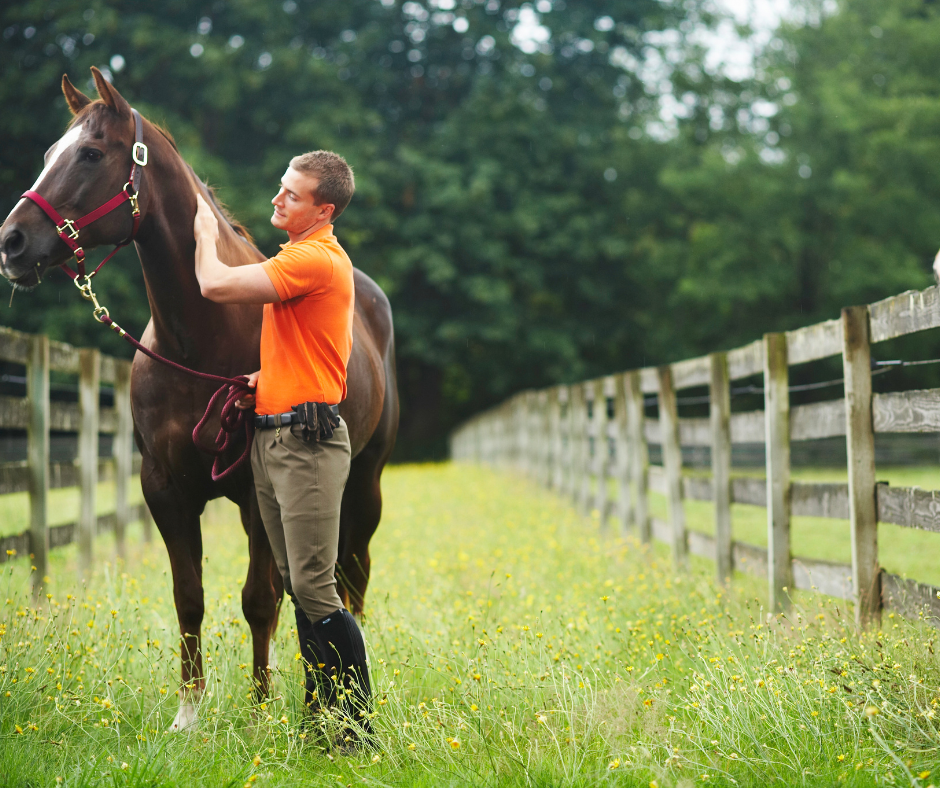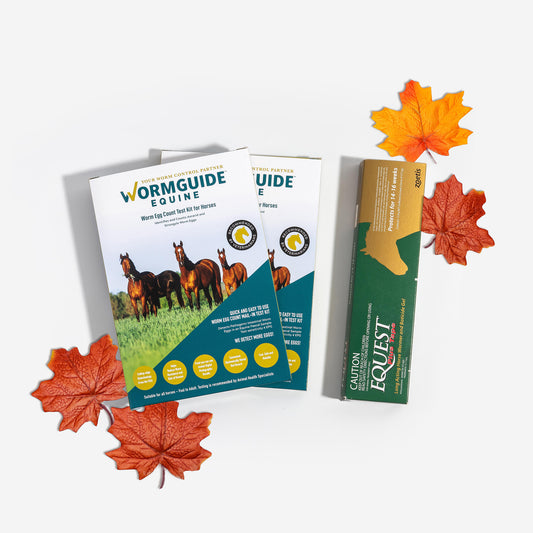As a leader in faecal egg count (FEC) testing, we`re on a mission to provide the most accurate and precise results for horses everywhere. That`s why your horse`s poo is tested with sophisticated AI technology for consistent reliability - and for you - improved confidence. Along with our biosafe poo sample collection, appropriate storage and a priority return mailer, our egg counts give you all the benefits you need for current worm control recommendations.
Every inclusion is chosen with intention: all with the purpose of boosting your up-to-date best practice worm control for your horses.
Our faecal worm egg counts reflect this commitment.
Worm control-Are you up to date?
We used to think we could keep our horses worm free and protect horses from intestinal worms that way. That was the philosophy - following schedules, rotational deworming , and calendars. Now we have come to realise that was not-best practice.
In the distant past deworming horses was grounded in theory, and like any other medical practice is applied, assessed and changed over time with new scientific knowledge and evidence.
Since the first effective deworming drug was discovered in the 1960s horse worms have been genetically changing to survive treatments that could previously kill them.
Its our turn to change! As painful as it is.
BUT...
What is very concerning for the health and welfare of horses is the resistance of horse owners and managers to change from the traditional not-best practice to modern best practice worm control.

Who is still de-worming the old way?
Recent surveys and studies in Australia show that the distant past interval-dosing and rotational deworming remain prevalent but problematic for the welfare of horses.
For example:
- A 2019 survey found that the majority of horse owners or managers in Australia reported they are still deworming horses using a blind (6-8 weeks) aggressive treatment practice with no faecal egg counts..
- In 2019 research found resistance in horse worms to all 3 classes of dewormers across NSW, QLD & VIC caused by the intensive use of dewormers.
- 2023 four year research indicate resistance in intestinal worms is rife across all major thoroughbred breeding regions in Australia. About 60% of thoroughbred breeders still cling to the old ‘interval-based’ deworming approach. Research lead, Prof. Abdul Jabber said,"This commonly used strategy is not only ineffective, it’s also contributing to escalating resistance to available dewormers." According to Prof. Abdul Jabbar, more than three-quarters of breeders surveyed were unaware of dewormer resistance on their properties.
What You Should Know About No New Deworming Drugs
We need to keep in mind we have what we have. We have not had a new deworming medication for horses for 40 years - that says it all. We are not likely to see a new type of dewormer for horses.
A terrifying forecast.
Adopting appropriate worm control practices to promote the wise use of dewormers to achieve sustainable control in intestinal worms is essential!
Feelin` Groovy?

Why you should forget the 8 week deworming schedule
Before the introduction of the first effective dewormer drug in the 1960s disease caused by the bloodworm (large strongyle) were common. The new drug contributed greatly to improving the health and welfare of horses.
Everyone thought `worm free horse` and never have to worry about worms again.
Scientists, vets and horse owners were so excited and began to talk about eradication of all worm types as if it were a realistic and desirable goal.
Downfall of the bloodworm.
Worm eggs started to reappear 8 weeks after a deworming treatment in horses` poop. Based on this finding, an aggressive 8 week deworming regimen was devised. The interval-dose program targeted the life-cycle of the bloodworm and was successful in reducing the occurrence of the bloodworm.
Rise of the small strongyle worm
Aggressive deworming had serious consequences. While the bloodworm became rare in managed horses (and still is), a new intestinal worm emerged to take its place: the small strongyle. All horses have this intestinal worm.
The small strongyle worm grow and develop in a different way. It has a much shorter life cycle compared to the bloodworm, therefore new generations happen quickly. Being exposed to the deworming drugs every 8 weeks for decades have allowed them to genetically change to survive deworming treatments that could once kill them.
"These worms require a different approach. It` ain`t the 60`s anymore"(Kaplan & Nielsen 2010).
Why you should forget rotational deworming
In the 1970s & 1980s two more drug classes were introduced. Rotation between dewormers was added to the 8 week schedule to avoid dewormer resistance. The apparent logic was that if one drug doesn`t kill`em , the other drug will.

Before you could buy dewormers over the counter, vets tube-wormed horses. They passed a stomach tube and dosed a large amount of deworming chemical directly into the stomach.
Rotation between dewormers doesn`t prevent or slow resistance and never did.
The flaw in the logic was that resistant worms are still on pasture so only removing worms from the horse doesn`t treat the resistant worms.
There are only three classes of dewormer drugs, and we have resistance to all of them. If you are rotating between dewormers, you`re very likely to use one, two or 3 of the drugs that don`t work anymore.
According to leading research horse scientists Dr Neilsen and Dr Reinemeyer, it appears rotational deworming actually promotes dewormer resistance across the different drugs.
Dr Martin Nielsen explains, rotational deworming—the long-held practice of treating horses every eight to 12 weeks with products of different chemical classes—has not prevented resistance the way it was once thought it would.
Dr. Martin Nielsen, Professor at the Gluck Research Center at the University of Kentucky, Co-editor in Chief for the journal Veterinary Parasitology, one of the world’s foremost equine parasitologists.
Why you should forget the every season deworming schedule
As opposed to the interval-dosing program, the `spin off ` strategic dosing takes seasonal differences into consideration. However, all horses were still blindly treated at fixed 12 week intervals during the year without faecal egg count information.
The number of treatments were lowered from six to four times a year but had no effect on slowing resistance.
What is refugia (And how do you get it)
Worms in Refugia is a tool used to slow dewormer resistance for all grazing livestock - cattle,sheep,goats,camels,alpacas,donkeys and horses.
Worms in refugia benefit your up-to-date worm control strategy in two ways.
Horse Refugia
Worms in refugia are the strongyle worms inside the horses that are left untreated.These worms are not exposed to a given drug at the time of deworming treatment. Selective (targeted) treatment strategy keeps the number of worming treatments at a minimum to delay resistance.
When you deworm ALL your horses on your horse property more than twice a year you kill more worms that are susceptible to the deworming drug and give resistant worms the advantage. Resistant worms do not die but carry on to breed more resistant worms. Keeping susceptible worms in refugia serve to dilute any resistant worms that are accumulating. This delays resistance.
Environmental Refugia
Worms in refugia are the free-living strongyle worm eggs and larvae on pasture. Environmental refugia helps you keep the number of worming treatments at a minimum.
- During temperature extremes of hot summers or cold winters and during droughts these worms have trouble surviving before being eaten by a horse. Refugia is low because the climate helps your worm control. When refugia is low, worming all horses on your farm is unnecessary, potentially harmful and a waste of money.
- During spring and autumn temperatures are more favourable for worm development in most climates. This is a better time to deworm all horses to knock down egg output and achieve a lower infection pressure on pasture.
Cue short video...
Here Prof. Martin Nielsen explains: What is Refugia?
How to Establish an Annual Worm Control for Adult Horses (over 3 years)
Selective therapy (or targeted treatments) promoted a decade ago by equine scientists and parasitologists to slow dewormer resistance may seem like another language at first.
The goal is not to eliminate all the worms because that`s impossible - and no de-worming product will do that for you anyway. Your plan is to reduce the number of strongyle eggs to achieve a lower infection on pasture.
What you should know about the WormGuide Super Surveillance Egg Count
Worm control is based on small strongyle worms. The guidelines are world-wide because horses are mostly affected by the same worms.
The Super Surveillance egg count provides the basis for selective (or targeted treatment) worm control in which horses with the lowest levels of egg shedding are left untreated creating refugia.
When the Super Surveillance Egg Count is used as a means of strongyle worm surveillance, the main purpose is to classify your adult horses as a low, moderate or high egg shedder.
The majority of horses shed relatively few eggs with 0 or low egg counts most of their lives even without deworming treatments.
Only a small number of horses are high egg shedders. They are responsible for more contamination of worm eggs on pasture. These horses are selected/targeted for an additional treatment beyond the once or twice foundation deworming of all horses.
Once you know the egg shedding status of your horse you are able to establish an annual worm control plan for each adult horses (over 3 years).
Beginner`s Guide: How often should horses be wormed?
A basic foundation of worming treatments should be considered to all horses. This should consist of one or two yearly treatments for large strongyles, tapeworms, bots, and spirurid nematodes responsible for causing summer sores (Habronema spp. and Draschia spp.). In most cases, one or two yearly treatments will achieve this goal. All further treatments should be targeting horses that shed most of the strongyle eggs on pasture.
The percentage of low to moderate egg shedders in adult horses is about 80% supporting the use of faecal egg count surveillance and targeted dewormer treatment strategies in adult horses, rather than interval-based deworming (2023 Abbas & Ghafar).
How WormGuide Egg Counts Help You Slow Dewormer Resistance
Strategic foundation treatments to all horses to maintain control over other worm types such as tapeworm, prevent return of the bloodworm and encysted small strongyles are recommended once or twice a year. Usually in spring and/or autumn in most climates. Beyond the foundation deworming focus on horses that have high egg counts to reduce strongyle worm egg output on pasture. This way you reduce the infection pressure without exposing all the worms to de-worming drugs.
All horses have small strongyle worms. Boost your modern surveillance worm control with more accuracy and precision than the outdated traditional microscope methods.
How the Super Surveillance Egg Count benefits your up-to-date worm control
To slow de-wormer resistance:
- Reduce de-worming treatments
- Tailor worm control for each horse
- Avoid unnecessary treatments
- Keep worms in refugia
- Reduce long-term cost of de-worming
- Improve welfare of horses











